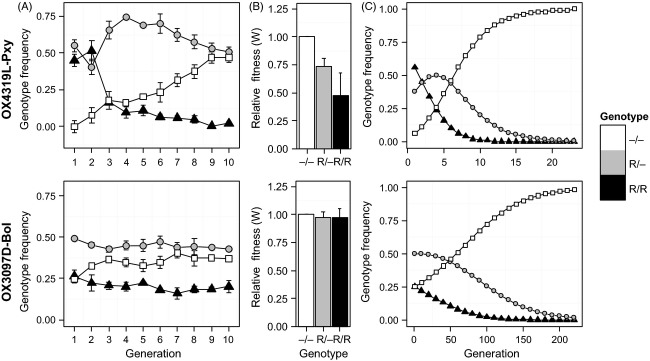Figure 2.

(A) Mean frequencies (±SE) of transgenic homozygous (R/R, triangles), heterozygous (R/–, circles), and wild type (–/–, squares) in two and three mixed-genotype populations of diamondback moth (upper panel) and olive fly (lower panel), respectively. Diamondback moth populations were established with 100 homozygous transgenic male and 100 heterozygous transgenic female insects. Olive fly populations were established with 100 heterozygous transgenic male and 100 heterozygous transgenic female insects. Experimental populations were observed for 10 generations. Engineered female lethality was suppressed throughout the experiment by provision of dietary tetracycline, and population size was maintained at 200 adults in each generation. (B) Relative fitness values for –/–, R/– and R/R genotypes (±SE) of OX4319L-Pxy (upper panel) and OX3097D-Bol (lower panel) calculated from corrected rate of increase parameters with values relative to the –/– genotype. Relative fitness values were WR/R = 0.477, WR/– = 0.736, and W–/– = 1 for diamondback moth and WR/R = 0.975, WR/– = 0.974, and W–/– = 1 for olive fly. (C) Results of a deterministic population genetics model illustrating theoretical genotype trajectories in mixed-genotype populations of diamondback moth (upper panel) and olive fly (lower panel) using the experimentally derived mean estimated relative fitness values from (B). Note that model outputs represent more generations than the cage experiment, to illustrate longer-term trajectories.
